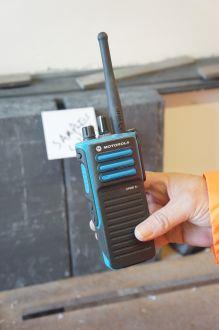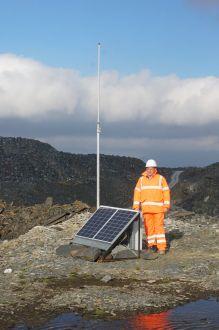A sharp left turn off the main road, an awkward zigzag as we pass under a railway bridge, and we’re on a narrow lane bordered by dry stone walls, heading steadily upward. Passing cottages and a converted chapel, we cross meadows and open moorland as the lane continues up the mountainside towards the tops of Snowdonia.
“I hope we’re not going to meet the tipper truck coming down,” says Colin Rogers a little anxiously, scanning the road ahead over his steering wheel. “Last time I was here I had to reverse half a mile to find a passing place.”
Rogers is responsible for business development at Lancashire-based mobile radio supplier In Touch, and today we’re on our way to visit one of its customer sites – Cwt y Bugail, one of three quarries in Snowdonia operated by Welsh Slate.
Luckily the tipper is busy elsewhere, and high above the valley we round a bend beside a mound of waste slate to arrive in the quarry yard. Ahead are two sheds where slate blocks from the pit are sawn and split into finished products.
We climb into a small truck with quarry manager Ceri Jones to see the workings. He takes us to a huge pit, and on the way a handheld radio in the vehicle bursts briefly into life with an exchange in Welsh. “The mountain has been mined, historically, from both sides. Now it’s one quarry,” explains Jones.
Peering into the chasm, the thick bands of grey slate are immediately obvious. They’re being broken into by blasting, and the fallen blocks are removed to the sawmill for processing and finishing.
Guaranteed quality
Mining began at Snowdonia two centuries ago, first by tunnelling under the granite into the mountain and more recently by excavating the open pit. Operating all year round, the quarry produces up to 30,000 roofing slates each week. Welsh Slate has been shipping slate around the world for hundreds of years.
And it is top-quality slate, Jones assures us. “We give a 100-year guarantee on it, whereas the Spanish give 20. We know how it weathers. It’s tried and tested.”
From the rim of the quarry we can see large openings in the rock face. These are the remains of the early tunnels and chambers, now being opened out as extraction continues. Jones comments that they have a history of their own; having been requisitioned in the Second World War as a safe storage place for art treasures removed from London galleries during the Blitz.
“I think it was Churchill who decided that they needed to be put underground somewhere,” he adds. “So they were brought up here and the tunnels were widened and sheds built underground with air conditioning, temperature control and so on. Everything was perfectly controlled for them.”
After the war the art treasures departed but the government mothballed the storage facility, maintaining it on standby throughout the Cold War. It was not until years later that quarrying into the mountain could begin to expand again.
Explosives and safety
Today machines do much of the heavy work in this once manpower-intensive industry, so the small workforce at Cwt y Bugail relies heavily on communications for efficient working.
Descending into the depths of the pit more Welsh crackles across the radio system. “It’s just for people to let others know where they are,” Jones explains. “We’ve got it so we can talk to each other on hairpins like this, with narrow roads in thick fog for much of the winter – we have weeks of fog sometimes.”
But most importantly, the radios are needed for safety. “The two-way radios will be written into the emergency action plan,” says In Touch’s Rogers who, as a former quarry manager himself, understands how Welsh Slate’s business works. “So if there’s an emergency on site the two-way radios will form part of that. I know they use them as part of their blasting protocol.”
“It’s very significant as far as health and safety is concerned,” comments Edward Griffiths, purchasing manager for Welsh Slate. “Up in the quarry we need to be in touch with each other, and with sentries, to make sure that nobody enters when we’re blasting – as well as when it’s foggy up there. They can communicate with the main office at the bottom, or the weighbridge at Bethesda where I am based. If anything goes wrong in the quarry they can at least get in touch with somebody down the bottom to get the emergency services out.”
Rogers explains that the sentries’ duties include monitoring a public footpath that passes close to the main finishing sheds. “They have to make sure that nobody is where they shouldn’t be before they do a blast. And that was where the old system was falling down, because they didn’t have the coverage.”

Sounding the all-clear
Blasting can take place two or three times each day so the quarry uses explosion-proof ATEX-rated radios – Motorola’s DP4401Ex handportable (pictured left).
“We use them to tell the excavator that we’re actually firing, and to move out – and to give the all-clear at the end,” says Welsh Slate’s Jones. “We want to unpick the rock like a big jigsaw: take it apart rather than shatter it. It could be two to three kilos of powder going off to give us a few lumps, or 70 to 100 kilos of powder going off to give us a larger shot.”
Looking upward, we catch sight of high-vis overalls moving about. “That’s where our shot-firer is, preparing a shot for later on,” Jones observes.
On the way back to the finishing sheds a huge dumper truck trundles past, returning to pick up more blocks. “We’ve only got one dumper on site at the moment,” he says “but we’re getting another one. They’ll talk to each other [via radio] so that they don’t meet each other on the road.”

Welsh Slate’s repeater
At one side of Welsh Slate’s Cwt y Bugail quarry sits the centrepiece of the on-site radio system; a rugged transportable DMR repeater designed and built by In Touch (pictured right). “It’s unique, made for the site,” says In Touch business developer Colin Rogers. “The principle behind this was that it was movable. There’d be nothing to stop them picking it up and moving it.”
The unit is built to withstand harsh conditions: at an altitude of 650 metres weather can arrive from all directions. Furthermore, there is no mains electricity supply so the system’s most distinctive feature is its twin 80-watt solar panels. These charge a battery to power the single-channel Motorola VHF repeater inside.
First installed at the beginning of the year as part of a replacement for the site’s old analogue system, the repeater enables workers in the quarry to contact the sawmill – something the analogue radios struggled with. Welsh Slate’s quarry manager Ceri Jones says he notices a slight delay through the digital repeater, but appreciates the clear speech quality and its suppression of wind noise.
Improving communications
At the site half a dozen radios are currently in use, plus a fixed station in the office. In Touch installed DMR radios at two other Welsh Slate sites in north Wales at the same time, but the systems are not interconnected because there was no requirement for that. However, all three are on VHF so that the radios are interchangeable. A mobile fitter, for example, could work at any of the sites without having to find a different radio.
In Touch’s Rogers explains that quarry radio systems are his company’s core business, and its customers include many of the UK’s major quarry operators. “We are always looking for ways to improve the systems for our customers,” he says. “So it’s a case of letting them know that if they’ve got coverage issues then that’s something we can address.
“The brief we normally have is that they just want two-way radios and coverage. It’s very rare that they ask for anything else. I think we’ve got maybe a dozen sites where it’s slightly more complex, so they can send text messages or do one-to-one calling. But that’s normally just for the site’s management. They are always working to quite tight cost restraints as well. And from the quarry manager’s point of view the simpler the better – because if it gets too complicated there’s a chance that they will just park the radios and not use them!”
Though DMR supports person-to-person calling as well as group calls Welsh Slate has not exploited this capability on its single-channel installations. “We forewarned them that it ties up the radio system,” Rogers recalls. “So although they are having a one-to-one conversation that nobody else can hear, no-one else can use the radios while they’re having this conversation. So I think that put them off a little bit. But to be fair I don’t think there’s a lot going on on-site where anybody needs privacy.”
Radio rentals
A quirk of quarry radio is that the equipment is predominantly rented rather than purchased. “I would say that 85 to 90 per cent of our customers go down the rental route,” says Rogers. “They pay a weekly rental fee for the radios and included in that will be maintenance and batteries. The only time they would ever get a bill from us would be if they lose a radio or destroy it beyond repair.
“It’s a continuously revolving rental fleet as well, so although a faulty radio may come back from site there’s a good chance it’s only a speaker or a broken push-to-talk [button], something that can be repaired. But not a lot goes wrong with them. We do our own repairs.”
For Welsh Slate renting is convenient and works well from a budgetary point of view. “We can add or subtract radios as and when we need them,” says Griffiths. “If we get an extra machine in we can just put a radio in it. Or more men working in the quarry – that kind of scenario. We know where we are from one month to the next.”



